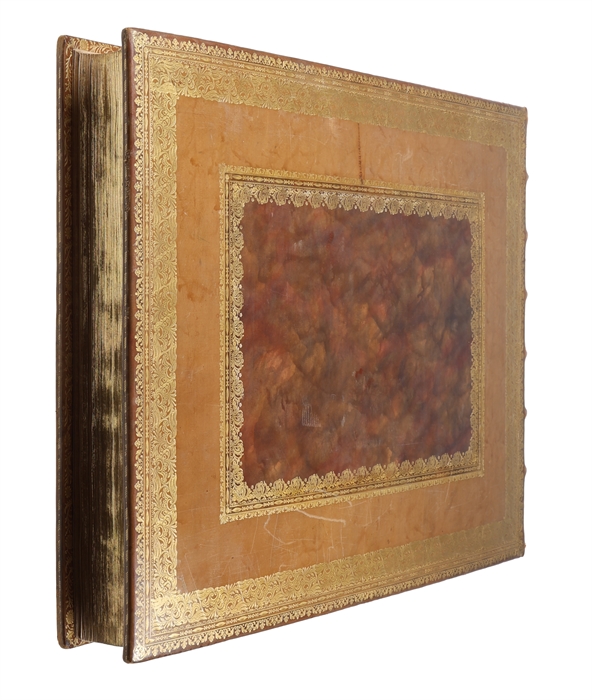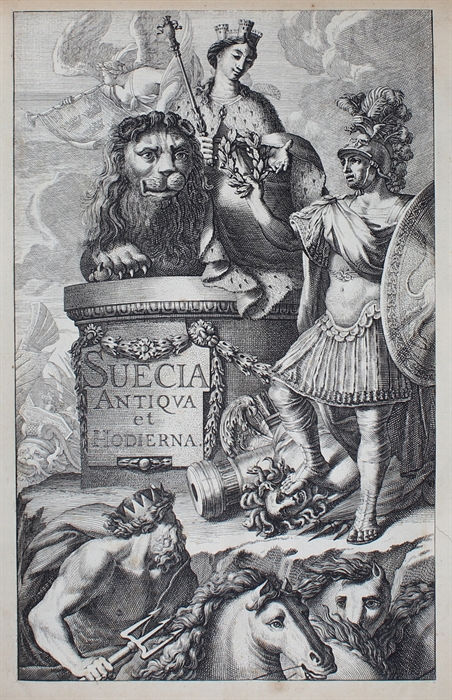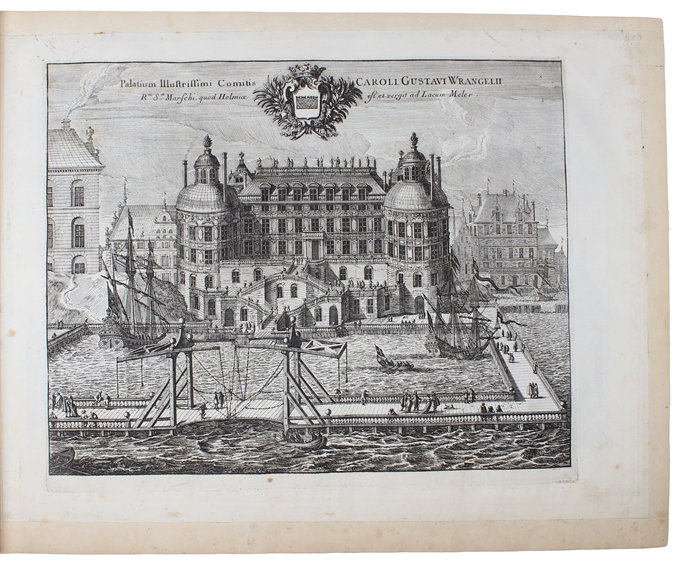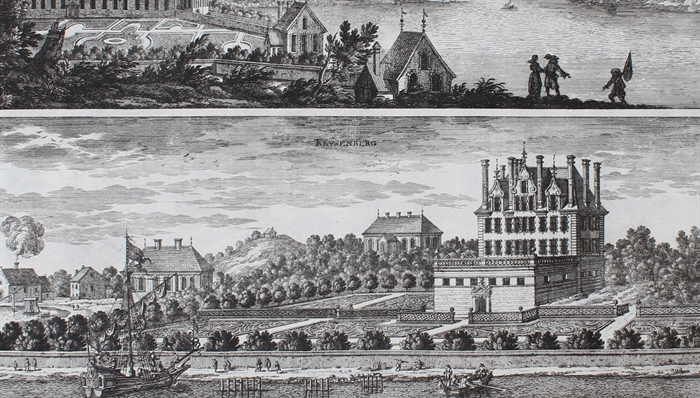THE LARGEST SCANDINAVIAN TOPOGRAPHICAL WORK - IN A MAGNIFICENT BINDING BY HEDBERG
DAHLBERG (DAHLBERGH), ERIK.
Suecia Antiqua et Hodierna. Tomus I-III (all).
Stockholm, (1661-1728).
Queer-folio (365 x 480 mm). Magnificent full polished calf binding from ca 1900 by the Swedish master bookbinder Gustav Hedberg in Stockholm. Sumptuously gilt spine with six raised bands and gilt title-label. Boards splendidly gilt with broad ornamental borders and a darker polished calf centre. Edges of boards gilt and inner gilt dentelles. All edges gilt. A prime example of a master binding by Hedberg.
Complete with all 354 engraved plates (including the three title-pages). At the end is withbound the "Index Figurarum Ænearum 1-3", 13 pp., which is not mentioned in Lindberg, Swedish Books.
The plates are printed on fine, heavy paper (”skrivepapir”) and are of varying sizes (folio, double folio, and composite). Here, they have been either mounted on or ”enlarged” in the margins, with contemporary fine heavy paper of the same sort as the plates, in order to make them of uniform size to fit the binding.
An unusually well preserved copy with only minor brownspotting, with clear prints on excellent paper. A few plates a little closely shaven (eg. the three title-pages).
A magnificent fully complete copy in a lavish masterly bookbinding by Gustav Hedberg of the largest and perhaps most sumptuous Scandinavian topographical work. ‘Suecia antiqua’ was an ambitious effort to document Sweden. The kingdom was then at the height of an aggressive expansion and very much aware that it had become a major power, primarily through its success in the Thirty Years War (1618-48) and campaigns against Denmark and Poland in the 1650’ies. In the course of this transformation, it took substantial new territories and sponsored many new and impressive architectural projects both at the state and the individual level, which were here presented to an international audience. Dahlberg's direct source of inspiration was the topographical publications issued by the Swiss publisher Matthäus Merian whom he had become acquainted with during his military service and studies in Germany: ”I want to produce a work on Sweden like that with which Merian honored Germany. Foreigners should see how much of greatness and beauty is to be found in our fatherland”. (Jonsson, Stormaktstid, 1992). “The compilation of architectural views emerged as a genre in the mid-sixteenth century and grew in popularity over the following two hundred years. They range widely in scope, ambition and intended purpose, with some constituting a kind of architectural monograph and others taking a regional or global focus as a form of topographical literature. Many are documentary; others contain imaginary or ideal buildings. Some emphasize text; others contain only a few captions. However, all have in common an attractive presentation that is not particularly technical, and would appeal to anyone with even a passing interest in architecture. It may be this easy accessibility that has often made them seem like ornaments for aristocratic libraries and largely removed from the more intellectually engaged worlds of the study and the architectural studio. With some exceptions, such as the rich works of Giovanni Battista Piranesi, they have typically been seen as early coffee table books - of limited use at the time, and important to the history of art and architecture primarily” (Kristoffer Neville, Suecia Antiqua et Hodierna: An Architectural Viewbook in the Eighteenth Century). The collation of the work is quite complicated, and the number of plates listed in bibliographies is not consistent. The printed index in the book lists 150+76+126=352; Lindberg lists 353 (150+76+127). The present copy has 354, including the plate of the Swedish Church in London (Templum Ulricæ), bound at the end, but before the Index and dated 1728. Brunet V:578. Swedish Court Bookbinder Gustaf Hedberg is considered the greatest Swedish bookbinder, widely famous for his magnificent, lavishly gilt full calf bindings. Especially those in larger formats are highly sought after and difficult to obtain. After having trained as a bookbinder in Paris (1881-85) and London, Hedberg returned to Stockholm in 1886 and opened his own workshop there. In the beginning, he mostly bound books for libraries, but he soon became known for his great skills, evolving into a true artist bookbinder, who bound books for the most prominent people in the country. He won first price for his bindings in both Chicago 1893 and Stockholm 1897, and in 1901, he became Court Bookbinder. He continued to travel to London and Paris, from where he brought back new techniques and styles to Sweden. Since 1969, the historic Hedbergs Bokbinderi, along with bindings and the workshop archives, has constituted its own a special part of Kunglika Biblioteket.
The scope and extravagance of the work was reflected in its printing history; In 1661, Dahlberg obtained a commission from the Swedish government to compile a pictorial archive of the country's architectural treasures. No less than 18 engravers were hired to transfer Dahlberg’s drawings to copperplates (a few of the drawings were by David Klöcker-Ehrenstrahl and Elias Brenner). After decades of transferring drawings to copperplates, 21 years were spent on completing the printing of the plates - the sheets continued to be published throughout the 18th and into the 19th century. Per Lagerlöf wrote a Latin text, but it was only partially printed and never published.
Lindberg: Swedish Books 1280–1967 as no. 37.
Collijn 4, 198.
Order-nr.: 28323





